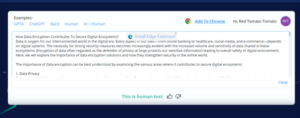Data is oxygen for our interconnected world in the digital era. Every aspect of our lives—from online banking to healthcare, social media, and e-commerce—depends on digital systems. The necessity for strong security measures becomes increasingly evident with the increased volume and sensitivity of data shared in these ecosystems. Encryption of data, often regarded as the defender of privacy at large, protects our sensitive information, leading to the overall safety of the digital environment. Here, we will explore the importance of data encryption solutions and how they strengthen security in the online world.
The importance of data encryption can be best understood by examining the various areas where it contributes to secure digital ecosystems:
- Data Privacy
Data encryption, in the age of privacy protection, is the ultimate guardian of personal and sensitive information. It makes it possible for authorized people to only access and interpret data, thereby safeguarding the privacy of people and organizations.
- Data Integrity
Secure digital eco-systems—data integrity. Encryption preserves data integrity by protecting information from unauthorized modifications in transit or storage. The encryption involves the utilization of an additional key to create a unique ciphertext thereby, the ciphertext is entirely different if any amendment is made to encrypted data.
- Confidentiality
Confidential information like financial records, medical histories, and personal communication is normally managed via digital ecosystems. With data encryption, even when intruders get into the system, they will be unable to understand the information without the decryption key.
- Compliance
The organization has to protect sensitive data through various regulations, including the General Data Protection Regulation (GDPR) and the Health Insurance Portability and Accountability Act (HIPAA). Adherence to these rules includes data encryption, which is a basic one.
- Risk Mitigation
Threats like data breaches, cyberattacks, and insider threats pervade today’s digital landscape. The use of encryption ensures that data is not exposed and minimizes possible damages in the event of an information security breach.
- Secure Communication
Secure communication is essential in today’s world of never-ending data on the move. With data encryption, the details transmitted over the Internet can be securely protected against eavesdropping and interceptions.
Data Encryption Solutions’ Role
Table of Contents
Data encryption solutions enable effective data encryption in digital ecosystems. Security solutions under discussion cover a wide list of technology and techniques used for safeguarding data against unauthorised access, maintaining confidentiality and integrity of data. Let’s explore some common data encryption solutions:
- Symmetric Encryption
Symmetric encryption uses one key for encryption and another for decryption. This method is effective and ideal for protecting data that is at rest. The problem is transmitting the encryption key securely among parties.
- Asymmetric Encryption
Asymmetric encryption, also known as public-key cryptography, uses a pair of keys: an encryption/decryption public-private key pair. This simplifies the key distribution but is complex at the level of computing, which is applicable when securing data on the move, like during online transactions and secure mailing.
- End-to-End Encryption
Asymmetric encryption is a specific application of asymmetric encryption, where data is transmitted encoded from the sender’s end, and only the recipient can decode it. Such communications are provided with maximum levels of privacy and security using this approach.
- Full disk encryption
Full disk encryption is a process that secures all data on an entire storage device or disk. The mode of operation is securing laptop, mobile, and desktop computers. The data remains protected regardless of where the device lands.
- Data Loss Prevention (DLP) Solutions
DLP helps organizations prevent unauthorized access to protected data. They encrypt this data, making it only possible for selected people to access, share, and modify such information, minimizing the risk of data breaches.
Encryption Key Management
Robust key management practices enable data encryption to be effective. As such, the protection of keys is an essential part of data security when it comes to encryption and decryption processes. Here are key aspects of encryption key management:
- Key Generation: The generation of secure keys is essential to guaranteeing that keys used for encryption are different and unpredictable. Cryptographic attacks can be foiled through stringent key generation practices.
- Key Storage: The encryption keys should be safeguarded from unauthorized access. This involves securing the keys from internal threats and hackers.
- Key Distribution: The secure transmission of keys for decrypting the data is crucial as it enables authorized parties access to the data. They are particularly important in asymmetric encryption, where a secure key distribution mechanism is vital.
- Key Rotation: By continually changing encryption keys, security increases, in particular when a key appears to be compromised. It’s important for data security over a long period of time to have a good key rotation strategy.
- Key Revocation: When there is a key compromise, key revocation procedures guarantee that a compromised key is no longer employed for encryption and decryption.
Data encryption challenges
While data encryption is a potent security measure, it comes with its own set of challenges.
- Key management complexity
With the implementation of encryption at scale, the management of encryption keys becomes increasingly important. Diligence and strong procedures are needed for good key management.
- Performance Overhead
However, the implementation of data encryption, especially with the use of powerful encryption algorithms, may result in high performance overheads. Organizations constantly find it challenging to juggle security with performance.
- User Experience
However, encrypting data may also bring some inconvenience to a user, like an extra authentication step to do and a reduction in the time data transfer takes place. It’s about hitting it right with security and usability.
Conclusion
In a nutshell, data encryption is the bedrock of secure digital environments. It safeguards personal data privacy, content integrity, and confidentiality so that private information is not misused by unauthorized people. Some of the tools include data encryption, involving symmetric and asymmetric encryption, end-to-end encryption, as well as full disk encryption.
Today, the adoption of data encryption is not optional but mandatory in the era of data breaches and cyber threats. We have a duty of care to safeguard the digital assets and confidential information assigned to our trusteeship. Through this, we create secure digital ecosystems that nurture trust and credibility in the digital world.




